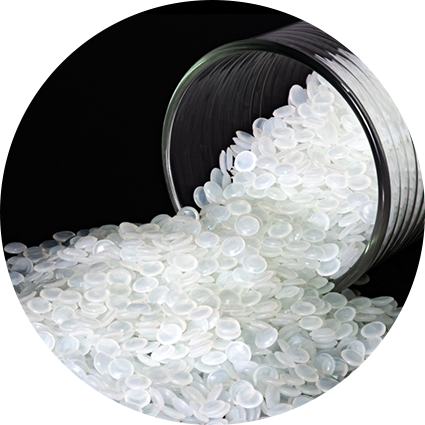The core advantage of BIO/M-2501A lies in its unique, fully biodegradable nature. This means it decomposes rapidly in the natural environment, preventing the long-term accumulation of plastic waste and thus reducing ecological pollution. Compared to traditional plastics, BIO/M-2501A fully biodegradable material's decomposition process is more environmentally friendly. It does not release harmful substances during degradation, thus preventing the harm of plastic materials to soil, water sources, and organisms.
Comparison table of BIO/M-2501A fully biodegradable materials and traditional plastic products:
| Comparison Dimension |
BIO/M-2501A Biodegradable Material |
Traditional Plastic Materials |
| Degradability |
Fully biodegradable, decomposes quickly in the natural environment with no residue |
Decomposes slowly, typically takes hundreds of years to fully break down |
| Degradation Products |
Only produces water, carbon dioxide, and natural organic substances |
May produce harmful chemicals (e.g., plasticizers, heavy metals) |
| Environmental Impact |
Non-toxic, harmless, does not pollute soil or water |
May release toxic substances, polluting the environment and harming ecosystems |
| Microbial Degradation |
Microorganisms can quickly decompose, promoting ecological restoration |
Microorganisms have difficulty breaking down, leading to long-term plastic waste accumulation |
| Food Safety |
Meets food safety standards, does not release harmful substances |
May contain harmful chemicals, compromising food safety |
| Usage Strength |
High tensile strength, suitable for daily use, resistant to pressure and wear |
High strength and durability, suitable for daily use |
Molecular structure design: the key to natural decomposition
The degradation performance of BIO/M-2501A material stems primarily from its unique molecular structure. Traditional plastics are typically composed of non-biodegradable polymers that take hundreds of years to decompose in the natural environment. However, BIO/M-2501A optimizes its molecular chain structure and incorporates rapidly degradable biodegradable units, making its molecular chain more easily degraded by microorganisms in the natural environment. In the natural environment, when BIO/M-2501A is exposed to air, moisture, and sunlight, certain chemical bonds within the material are broken down by biological processes such as microorganisms and enzymes, resulting in polymer chain scission. This structural change makes the material more susceptible to biodegradation, ultimately breaking down into harmless substances such as water, carbon dioxide, and biomass.
Microbial Action: Accelerating the Degradation Process
BIO/M-2501A is subject to microbial action during its degradation process, which is key to its rapid decomposition. Microorganisms are ubiquitous in nature and can decompose a variety of organic materials, including plant debris, animal carcasses, and various biodegradable plastics. The molecular structure of BIO/M-2501A is specifically designed to provide a good nutrient source for these microorganisms. During the decomposition process, microorganisms break BIO/M-2501A down into simpler compounds, such as water and carbon dioxide, which are common substances in the natural environment and harmless to the ecosystem. The key to this process lies in the material's biodegradability. Specifically, the molecular design of BIO/M-2501A enables microorganisms to easily recognize and degrade it, without requiring specialized environmental conditions or a long degradation cycle. This allows BIO/M-2501A to decompose much faster than traditional plastics, completely degrading within a few months or a year, thus avoiding long-term environmental pollution.
Non-toxic Degradation: A True Guarantee of Environmental Protection
In addition to its rapid decomposition, another advantage of BIO/M-2501A is its non-toxic degradation. Conventional plastics often release harmful chemicals, such as plasticizers, heavy metals, or microplastics, during degradation. These substances are not only harmful to the natural environment but also pollute water, soil, and even organisms. In contrast, BIO/M-2501A does not release harmful substances during decomposition, ensuring that its degradation products are completely safe.
When BIO/M-2501A decomposes in the natural environment, its degradation products are simply water, carbon dioxide, and natural organic matter—all naturally occurring substances in Earth's ecosystems and pose no harmful impacts to soil or water sources. This non-toxic and biodegradable property makes BIO/M-2501A not only compliant with environmental standards but also helps reduce pollution, particularly in food packaging and everyday consumer goods packaging, providing a dual guarantee for consumer and environmental health.
Wide Applicability: From Plastic Bags to Food Packaging
BIO/M-2501A's fully biodegradable nature makes it an ideal alternative to many traditional plastic materials. This is particularly true for everyday packaging products like shopping bags, milk tea bags, and courier bags. The long-term accumulation of traditional plastic bags can seriously pollute the environment, but BIO/M-2501A's biodegradable properties effectively address this problem. Due to its short degradation time (typically within a few months to a year), these materials disappear rapidly in the natural environment, reducing the long-term accumulation of plastic waste and meeting modern society's environmental protection needs.
As a food packaging material, BIO/M-2501A ensures food safety while reducing plastic pollution through rapid degradation. For example, milk tea bags and takeout bags made with BIO/M-2501A not only ensure food safety and hygiene but also quickly degrade after use, eliminating the long-term accumulation of food packaging waste.
Degradability and Cost-Effectiveness: Prioritizing Both Environmental Protection and Economics
While environmental protection is a major advantage of BIO/M-2501A, its cost-effectiveness is equally important. BIO/M-2501A does not incur excessive production costs, especially in large-scale production. Its high cost-performance ratio makes it an economical and environmentally friendly alternative to traditional plastics. For most companies, BIO/M-2501A not only meets environmental requirements but also helps reduce production costs and ensure market competitiveness.
BIO/M-2501A is suitable not only for the packaging industry but also for a variety of other sectors, including agriculture and consumer goods. With the continued implementation of environmental protection policies, market demand is expected to increase. More companies will gradually adopt this material to meet consumer demand for environmental protection and sustainable development.










